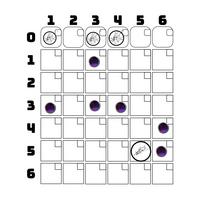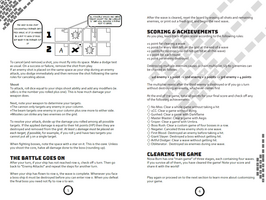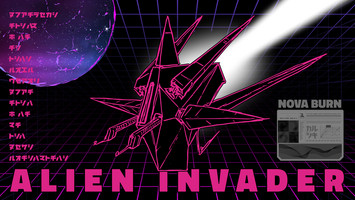Nova Burn Devlog



Nova Burn is out now.
For about a year now I’ve been stewing on how one could combine the tabletop RPG space with the shoot ’em up game. The first iteration of this particular conjunction was going to be very delineated: you would roleplay as your pilots then go and shoot stuff in a GM-less combat system. Said system was something between Four Against Darkness in its random enemy generation and Deep Space D-6 by way of its rapid combat resolution.
Things simply did not click with this system.
Character generation was superficial and combat was bloated, overly so, in its superfluity and captured neither the strategy nor the vibe of STGs. There is little-to-no movement in “theater of the mind” numerical combat and shmups require movement.
And yet I would not do a full-on boardgame.
So the thing sat in the cooker for, again, nearly a year. I’d peek at the design doc from time to time as my understanding of game design and the shmup genre as a whole grew. No progress was made, but inspiration glimmered here and there. The excellent Takuma Okada created a kind of inertia in me to release a simple, free game; every book I do should not, cannot, require a Kickstarter campaign or complex workflow. There must be essential, “low stakes,” but high quality releases (my reasoning behind which might stand a separate essay) and perhaps this shmup thing could serve as such an exemplar. But one needs a game to release to release a game.
I also adore the idea of an RPG as a kind of activity book: a self-contained paperback one can write in on a Sunday afternoon, ensconced in a quilt with a cup of tea or strong drink. But, again, there must be an actual game to insert into this design goal.
Then a surprising twist occurred and broke me through the block: Pathfinder.
Pathfinder kind of sucks. Given my own way, I would probably not play Pathfinder; I find it unnecessarily clunky and counterintuitive. The depth of customization and mechanical satisfaction is there but my brain runs on limited resources. It’s a war game and not a story game. But, my regular RPG group knows it and likes it and we returned to it earlier this year to embark upon high seas adventure. Refreshing myself on the 3.5 grid combat put a puncture wound in my writer’s block. The vague, artificial action of my initial design could be overcome by using a more tactical approach. In my minds eye I saw shooter combat, but in slow motion.
Adapting this notion to a solitaire game space was not especially difficult through my inelegant design methods. When creating such games I enact constraints to increase accessibility: the average person may not have a wide array of gaming accessories available in their homes, but you can be damn sure they probably have a d6 or can use a free one online (cf again Okada and their use of standard cards). Within such constraints the rest of the design fell into place. 2d6 (or 1d6x2) can randomly place things on a simple grid, things like bullet patterns; a simple grid dictates how many pieces can fall into place and how those pieces might move or act; slapping the paint of scifi space shmup combat on it is easy enough, as is adapting the language to create the retro shooter aesthetic.
In short, the grid itself became that final pull of potential energy; the rest was an easy ride down the hill.
A name, though. The name is everything: the selling point, the first line of marketing, the invocation to the reader’s imagination. That took time.
David Milch said of Deadwood that he learned everything he could about the historical Deadwood, SD of the 1870s…and then spent a year forgetting about it. In such a lull the knowledge becomes “digested” into the background of the mind. It’s a part of the landscape. When he came back to Deadwood to actually write the show, it was there but in a vague and intuitive, and therefore malleable, form; a liquid asset to be infused into his writing in a more natural way.
That was the hope when it came to naming this game.
Sure, I did the usual thing and hit up some google searches as well as the thesaurus. But better to let the thing sit and percolate, to hope that all the shmup games I’ve played and all the reviews and essays I’ve ingested could come up with something natural and intuitive. And then one day it appeared: Nova Burn.
Thankfully a quick search revealed that it was not a game or band I’d heard of before. It wasn’t anything except an odd dietary supplement, and that was good. No confusion in that marketplace. With a name the rest comes easily enough and soon one has ship names and other vagaries required to frame up an aspecific space setting in which to explode things.
A bit of playtesting (simple when creating a solitaire game and when virtual tabletops are a thing), a few tweaks, a few knob turns later and we have it; a finished game, ready for art and layout and then ready to be released for free digitally and cheap physically.
Why this, though?
I showed this to Dace over at shmuptopia and he was enthusiastic, but asked about how much more I was going to push the product; how many people was I going to show it to before release?
I explained that a one player tabletop combat game mimicking shoot ’em up games is a niche in a niche (in a niche?). So while a bigger release, a complete package, a more extensive testing and marketing process, maybe even the creation of a boxed game (though that has been done), would be great and perhaps even deserving of Nova Burn, such a niche product is the perfect target for a small-scale free release. The design reflects this principal: easy rules in an easily accessible package.
So Nova Burn is ready for you to play. If it hits, it hits. If it finds its audience then more’s the better. And even it makes a real splash, then you now what? Nova Burn Final sounds like a great time to me.
Files
Get Nova Burn
Nova Burn
Tabletop Shmup Action
| Status | Released |
| Category | Physical game |
| Author | Shoreless Skies Publishing |
| Genre | Role Playing |
| Tags | Shoot 'Em Up, Singleplayer |

Leave a comment
Log in with itch.io to leave a comment.